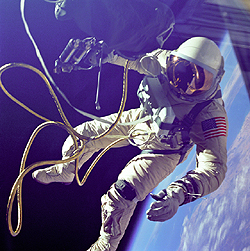
Photo courtesy of NASA-GRIN DataBase Number: GPN-2000-001180
Interest in rockets goes back to ancient times when the Chinese used rockets that burned solid fuel for entertainment and for warfare. The British and other Europeans used rockets in the 19th century for military purposes. They were also used for peaceful purposes such as for launching life-saving equipment from shore into the water to rescue sailors. A major problem was that these early rockets used solid propellants, which lacked much power, and they were unguided, meaning that they rarely hit their target.
In the 20th century engineers began developing liquid-fueled rockets and guidance systems. In World War II the Germans succeeded in inventing rockets that could be guided to more distant targets with rough accuracy (the ability to hit city-sized targets 100 or more miles away). When the war ended, hundreds of German rocket experts came to the United States and were instrumental in developing the American space program. The Soviet Union also used German rocket experts, but did not incorporate these people into their own space program. After obtaining their knowledge, the Soviets confined them to Germany and allowed them to conduct only non-rocket research.
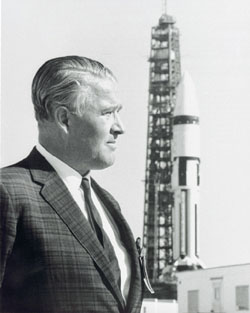
Photo courtesy of NASA: MSFC Center Number: 6863092 GRIN DataBase Number: GPN-2000-000045
Three people are generally considered the fathers of modern spaceflight-Austrian Hermann Oberth, Russian Igor Tsiolkovsky, and American Robert Goddard. All three worked in relative isolation from each other during the early part of the 20th century. Oberth and Tsiolkovsky were largely theorists, writing about orbits and the possibility of space travel. Tsiolkovsky wrote about space stations. Both men's writings influenced many people, particularly in their own countries, to believe that spaceflight was possible. Unlike Oberth and Tsiolkovsky, Robert Goddard was more of a hands-on engineer than a theoretician. He was the first person to research liquid-fueled rockets and developed several gasoline-fueled experimental rockets that he fired at a test range near Roswell, New Mexico. But because he was reclusive he did not pass many of his accomplishments on to others and did not train younger engineers how to build rockets; this may have slowed the progress of rocketry in the United States.
Spacecraft and spaceflight missions fall into three main categories: human spaceflight, Earth-focused spaceflight, and astronomical and planetary spaceflight. The first vehicle launched into space was Sputnik, which the Soviet Union shot into orbit in October 1957. Sputnik was the opening round in what became known as the "Space Race," where the United States and the Soviet Union competed to achieve various firsts in space in order to demonstrate the superiority of their political and economic systems and their way of life. The Space Race continued for the next three decades, but lost considerable momentum by the 1970s and 1980s. Spaceflight is flight that occurs beyond the Earth's atmosphere using vehicles called spacecraft. Spacecraft can orbit around another body-these are called satellites-and can also travel between and beyond planets into the distances of outer space. In common usage, satellites refer to spacecraft that do not have a crew on board. These are often called unmanned or robotic spacecraft, and robotic spacecraft that travel to other planets are often called space probes.

Photo courtesy of NASA GRIN DataBase Number: GPN-2002-000155
In 1961 the Soviets sent the first human into space-Yuri Gagarin. Human spaceflight quickly became the main aspect of competition in the Space Race, and the most expensive. Although the Soviets undoubtedly won the opening rounds of the Space Race, the United States caught up quickly and by the mid-1960s had passed them in terms of total hours of humans in space and other accomplishments. The ultimate achievement was the landing of Neil Armstrong and Edwin "Buzz" Aldrin on the moon in 1969. It was this Cold War competition, rather than a strong interest in science or the mysteries of space, that served as the incentive for both countries to invest the large amounts of resources that they have in their respective space programs, and especially in their human spaceflight programs. Once the Cold War ended by 1991 with the collapse of the Soviet Union, money for spaceflight decreased and in many ways, the continuing space programs of the United States and Russia are a result of political and bureaucratic inertia, with tens of thousands of jobs depending upon continuing spaceflight.
The most ambitious human spaceflight program, from both a technological and a financial standpoint, is the International Space Station, or ISS, now being developed by a consortium consisting of Russia, the United States, Europe, Japan, and others. The ISS involves extensive cooperation between the United States and Russia and is intended to symbolize the end of Cold War animosity. But it has proven to be an astoundingly expensive project and these costs have dramatically reduced its scientific potential. Because a significant amount of human activity in space involves fixing things that break, the ISS cannot produce any useful scientific data until it has a crew size greater than three, which can only be achieved at considerable new expense. As a result, even today, after the end of the Space Race, most human spaceflight remains more symbolic than beneficial or practical. Robotic, Earth-focused spaceflight offers the most direct benefits to those on Earth. Communications satellites, meteorological satellites and remote-sensing satellites fall into these categories.
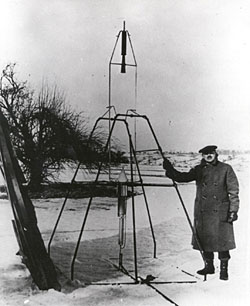
Photo courtesy of NASA
Communications satellites enable audio, video and data signals to be transmitted around the globe quickly and efficiently, shrinking the size of the Earth as people around the world can communicate with each other almost instantaneously. Meteorological satellites enable scientists to "see" the Earth's atmosphere. Instruments on board meteorological and other atmospheric research satellites measure and sample the atmosphere from great distance, identifying areas that may lead to severe storms. These satellites allow meteorologists and researchers to forecast major weather events like hurricanes and track their development and movement, and warn people to get out of the way. They have saved countless lives. Atmospheric observation satellites are also used to monitor ocean currents and temperature and to analyze trends such as global warming, ozone destruction, and pollutants in the atmosphere. They have played a major role in the debate over human impact on the environment.
Remote-sensing satellites view the Earth's surface. They are used for agricultural and land-use monitoring. But their primary use is military. Reconnaissance satellites, operating in polar orbits, are used to monitor troop movements, construction, and other military activities. Surveillance satellites in geosynchronous orbit watch for missile launches. Signals intelligence satellites in similar orbits listen for the faint whispers of electronic signals such as radio transmissions and radar.
Some spacecraft study the sun as well as its interaction with the atmosphere. This information can be of general scientific use and can also be important for understanding weather and global climate change. Astronomical spacecraft operate in Earth orbit and observe distant objects like stars and galaxies. Away from the distortions produced by the atmosphere, large observatories like the Hubble Space Telescope can see farther than any Earth-based telescope could ever see. They are investigating how the universe began, how it has evolved, its age and other mysteries.
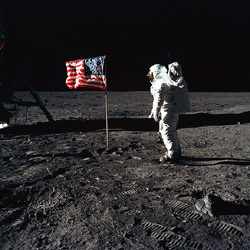
Photo courtesy of NASA GRIN DataBase Number: GPN-2001-000012
Planetary exploration spacecraft leave Earth orbit to explore the inner and outer planets as well as other objects in the solar system. Spacecraft have been sent to every planet in the Solar System excluding Pluto, and more recently to several comets and asteroids. The Moon remains the only object besides Earth to have been visited by humans. Mars is the most heavily explored planet due primarily to its similarity to Earth and its relative proximity to Earth. Mars, which had abundant water millions of years ago, may have once supported life and evidence of past life on Mars would be a major scientific discovery. During the 1990s, scientists became increasingly interested in Jupiter's moon Europa, which has a vast ocean under its ice and is therefore a prime site in the search for life.
The Space Shuttle is a unique and highly versatile launch vehicle. It can be used to carry a payload in its cargo bay that is released and launched into space. The Space Shuttle presently is the only reusable launch vehicle, and in fact the only reusable spacecraft. Because expendable launch vehicles are so expensive, the Space Shuttle was intended to lower the costs of launching a pound of payload into space. It has dramatically failed to do this. The United States has spent considerable money trying to develop cheaper reusable launch vehicles, or RLVs, to lower the cost of launching payloads, but has not been successful so far. More extensive exploitation and exploration of space, including things like space tourism, is not possible until the cost of reaching space comes down dramatically.
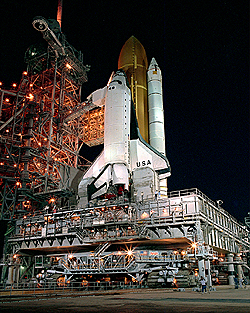
Photo courtesy of NASA GRIN DataBase Number: GPN-2000-000669
Launch vehicles are virtually the same as rockets and missiles. The term "missile" is usually used when the vehicle does not actually enter orbit and when the payload-what the launch vehicle is carrying and propelling into space-is some sort of weapon. Most modern launch vehicles consist of more than one stage. This means that two or three rockets are joined together, each with its own rocket motor, to form a single launch vehicle. During launch, these stages fall off as the rocket motors are fired and as the payload is gradually maneuvered into its proper position. When a launch vehicle or rocket releases its payload, it is said to deploy its payload. Modern rockets are extremely expensive to operate, frequently costing thousands of dollars per pound of payload placed in orbit.
Although the United States and Russia (formerly the U.S.S.R.) have led in spaceflight, other countries have developed their own space programs and are also participating more and more in cooperative space missions. Astronauts from numerous countries have flown into space aboard Russian and American spacecraft and work on the International Space Station. By the late 1990s, China had started development of its Shenzou spacecraft to transport several humans into space, and was reported to be working on its own space station. Spaceflight has a unique ability to capture the imaginations of all kinds of people who will probably never go into space themselves.
A longer and unedited version of this essay, originally titled Spaceflight-An Overview, by Dwayne Day, can be found at the U.S. Centennial of Flight's website
Visit the National Park Service Travel American Aviation to learn more about Aviation related Historic Sites.
Last updated: May 27, 2019
